- 1Invasive Insect Biocontrol and Behavior Laboratory, Beltsville Agricultural Research Center-West, USDA-ARS, Beltsville, MD, United States
- 2Department of Biological Sciences, Towson University, Towson, MD, United States
- 3Department of Entomology, Rutgers University, New Brunswick, NJ, United States
- 4Trécé Inc., Adair, OK, United States
- 5Appalachian Fruit Research Station, USDA-ARS, Kearneysville, WV, United States
Drosophila suzukii, more commonly known as the spotted-wing drosophila (SWD), is an invasive pest of soft, thin-skinned fruit responsible for significant economic losses for growers worldwide. To detect and monitor this pest, several host attractants have been developed for use in trapping SWD; however, they lack selectivity. Therefore, there is a significant need for more selective monitoring devices to enable growers to make timely pest management decisions to properly protect vulnerable crops. Previous studies identified a quinary blend (QB), based on fermenting apple juice odors, which offers significantly higher selectivity by reducing non-target captures compared with the standard apple cider vinegar bait commonly used by growers in the orchards. In this study, the selectivity and efficacy of a home-made QB dispenser was compared to an industry formulated version of the QB components (ChemTica) and two commercially available (Scentry and Trécé) SWD dispensers across blueberry and raspberry fields in Maryland, West Virginia, and New Jersey in different seasons. Controlled-release dispensers of the QB (home-made and ChemTica) consistently had higher selectivity within the blueberry and raspberry field sites compared with the two commercial dispensers; although efficacy was compromised such that total SWD captures per trap tended to be lower. The selectivity ratio range of SWD to non-targets (all non-SWD) for a QB-based (ChemTica) dispenser averaged from 15 to 57% compared with other commercial dispensers that ranged from 1 to 30% based on location and year. Due to high selectivity of the controlled-release dispenser of the QB, the potential for this dispenser to be utilized by growers as a SWD detection and monitoring tool is high.
Introduction
Spotted-wing drosophila (SWD), Drosophila suzukii Matsumura (Diptera: Drosophilidae), is an invasive vinegar fly that inflicts significant damage to soft, thin-skinned berries and stone fruits worldwide (Beers et al., 2011; Hauser, 2011; Bellamy et al., 2013; Asplen et al., 2015) resulting in significant economic losses (Goodhue et al., 2011; Walsh et al., 2011; Farnsworth et al., 2017; Yeh et al., 2020). Although SWD prefers small fruits such as raspberries, blueberries, and strawberries, it can under certain circumstances attack and infest other fruits such as grapes and apples (Dreves et al., 2009; USDA-APHIS, 2010; Mortelmans and Beliën, 2012; Cai et al., 2019). In order to mitigate the damage caused by this pest, previous studies have endeavored to develop attractive blends made from different host volatile organic compounds to be utilized as synthetic lures for monitoring and trapping of SWD (Landolt et al., 2012; Cha et al., 2014, 2015; Kleiber et al., 2014; Akasaka et al., 2017; Feng and Zhang, 2017; Jaffe et al., 2018; Zhang and Feng, 2020). The commercially available Scentry (Scentry Biologicals, Inc., Billings, MT, United States) and Trécé (Trécé Inc., Adair, OK, United States) SWD dispensers were developed from a 4-component blend of acetic acid, ethanol, acetoin, and methionol (Cha et al., 2014). This blend was shown to have higher efficacy compared to the standard apple cider vinegar bait (ACV; Cha et al., 2015); however, due to its relatively poor selectivity, indicated by high non-target captures, there is still a need for further lure development to improve SWD monitoring (Basoalto et al., 2013; Burrack et al., 2015; Mazzetto et al., 2015; Hamby and Becher, 2016; Feng et al., 2018; Tonina et al., 2018).
Previous research has shown that ACV contains fermentation components that are highly attractive to Drosophila spp. (Mallis, 1969). ACV has been regularly utilized as a cost effective and easily obtained bait for SWD in different orchards by growers (Beers et al., 2011; Lee et al., 2011). In addition to utilizing ripening fruits for oviposition, SWD females are also attracted to fruit wastes including rotting apple and other over-ripe or composting fruits as potential off-season oviposition substrates (Bal et al., 2017). With this in mind, Feng et al. (2018) analyzed the volatile profiles from fresh and fermenting apple juices. Five components of the fermenting apple juice blend: acetoin, ethyl octanoate, acetic acid, phenethyl alcohol, and ethyl acetate were identified as SWD attractants. All of these compounds can also be found in wine and other fruit odors and are produced in greater amounts through the fermentation processes, which has been shown to be attractive to SWD (Feng et al., 2018). Acetoin was determined to be a long-range attractant, while ethyl octanoate was a short-range attractant. The remaining three components acted as synergists to enhance the attractiveness of acetoin and ethyl octanoate. Preliminary testing showed that the selectivity for SWD of this quinary blend (QB) approached ca. 50% (Feng et al., 2018). When formulated this synthetic QB into polyethylene bags as a controlled-release dispenser, a significant reduction in non-target drosophilid captures was observed (Larson et al., 2020). This reduction in non-target drosophilid capture is needed to reduce the time required to identify SWD within the trap, in addition to reducing the chance of misidentification, and ultimately improving sampling efficiency (Kirkpatrick et al., 2017; Cloonan et al., 2019). Furthermore, elucidation of attractive components from fermenting apple juice odors could help develop a lure that outcompetes the background odors, and thus interrupts the host and oviposition site seeking behavior of SWD, within desirable crops. Over the course of fruit development, the amount of host odors within the environment changes over time. Observations have already been made that, during the fruiting season, SWD capture rates are lower than in the off-(post-harvest) season, which is likely due to an increase in SWD population size as the season progresses but also possibly to host odors overpowering the lures (Hennig and Mazzi, 2018; Cloonan et al., 2019; Singh et al., 2021). Moreover, rotting fruits as well as other durable fruits and fruit pomace/compost can attract SWD and provide an important late or early season reproductive resource when small fruit crops are not available (Bal et al., 2017). Development of more selective lures or lures that can be highly attractive during the fruiting and non-fruiting periods to give growers an early warning of infestation is paramount for SWD control.
To determine the potential of a novel QB-based dispenser as an integrated pest management tool for SWD, a comparison to currently available commercial dispensers is needed. To that end, a multi-year (2017–2018), multi-season (early season, harvest, late season, and off-season), multi-state [Maryland (MD), West Virginia (WV), and New Jersey (NJ)], and multi-crop (blueberry and raspberry) trapping field study was conducted in the United States to compare the efficacy and selectivity of a synthetic home-made QB dispenser and an industry formulated version of the QB dispenser (ChemTica) with commercially available dispensers (i.e., Scentry and Trécé). Results of this study also provide some useful information that can help understand the seasonal population dynamics of SWD in the Northeast region of the United States.
Materials and Methods
Chemicals
All compounds utilized within this research were purchased from Sigma-Aldrich (St. Louis, MO, United States): acetoin (AT, 3-hydroxy-2-butanone), 99%, CAS 512-86-0; ethyl octanoate (EO), 99 + %, CAS 106-32-1; acetic acid (AA), 99.7 + %, CAS 64-19-7; phenethyl alcohol (PE), 99 + %, CAS 60-12-8; and ethyl acetate (EA), solvent grade, CAS 141-78-6.
Trap
Commercially available Victor® yellow jacket & flying insect traps (Great Lakes IPM Inc., Vestaburg, MI, United States) were used to house the tested dispensers. Liquid traps containing a commercial dispenser or the uncontrolled-release dispenser were filled with ∼300 mL of tap water containing 1.1 ml/L of surfactant (Free & Clear natural dish liquid, Seventh Generation Inc., Burlington, VT, United States) as a drowning solution (Feng et al., 2018; Zhang and Feng, 2020). For activity comparison, Victor® traps filled with 300 mL of ACV (Essential Everyday 5% acidity, Supervalu Inc., Eden Prairie, MN, United States) and the previously mentioned surfactant were placed as well. Control traps consisted of the Victor® traps filled with ∼300 mL tap water and the surfactant.
Dispensers for Quinary Blend With Liquid Traps
The preparation of QB dispensers has been previously described in Larson et al. (2020). In short, a cotton ball, inserted into a micro-centrifuge tube (1.5 mL Eppendorf micro-centrifuge tube, VWR International, Radnor, PA, United States), had 1 mL AT: EO (1:1) loaded onto it. The lid was sealed for transport to the field. Once in the field, the lid was opened and the centrifuge tube was snapped into one of the four openings within the Victor® trap lid (Feng et al., 2018; Zhang and Feng, 2020). PE and a blend of AA and EA (3:1) were then added directly to the drowning solution in the Victor® trap at volumes of 1 and 20 ml, respectively.
Spotted-Wing Drosophila Dispensers
The commercially available SWD Scentry dispenser was purchased from Scentry Biologicals Inc. The Trécé dispenser, Pherocon® (High Specificity Dispenser or PEEL-PAKTM) was purchased from Trécé Inc. The ChemTica (ChemTica International S.A., Heredia, Costa Rica) QB dispensers 4-bag formulation (AT and EO in 1: 1 ratio in single bag) and 5-bag formulation (AT and EO in separate bags) of the same components previously mentioned for the QB dispenser were obtained as free gifts from AgBio Inc. (Westminster, CO, United States, not commercially available).
Field Tests
Several locations were selected for trap deployment. Sampling occurred from June to December 2017 and 2018 at a commercial U-Pick farm in Germantown, MD, United States. Traps were deployed in a managed highbush blueberry field, a managed raspberry field, and two nearby wooded areas. During the summer of 2018 additional traps were deployed in highbush blueberry fields at the Philip E. Marucci Center for Blueberry & Cranberry Research (Chatsworth, NJ, United States), a commercial organic farm in Hammonton, NJ, United States, and an abandoned farm site in New Jersey (Chatsworth, NJ, United States). Additionally, traps were placed in a raspberry field during the summer of 2018 at the USDA Appalachian Fruit Research Station (Kearneysville, WV, United States). All traps were collected every 7 days and were spaced a minimum of 5 m apart. The contents of the liquid traps were emptied into separate containers and returned to the laboratory for identification. Liquid traps were then refilled and randomly placed within the testing areas. Components of the quinary dispenser that were contained within the drowning solution (AA, EA, and PE) were replaced weekly. The components contained within the centrifuge tube (AT and EO) were replaced every other week. Blank control liquid traps consisted of a Victor® trap filled with only the tap-water/soap drowning solution. Trécé dispenser was changed every 2 weeks. ChemTica and Scentry dispensers were changed every 2 to 4 weeks.
Maryland
On June 15, 2017, liquid traps baited with uncontrolled-release dispensers, ACV, Scentry dispenser, and the ChemTica (5-bag) formulation were hung from the branches of mixed variety highbush blueberry bushes. The traps were deployed in six rows skipping one row in between each treatment row (ca. 10 m). Each row received two of each treatment for a total of eight traps per row. Twelve replications were tested for each treatment (N = 12). Traps were set up similarly within a nearby wooded area (ca. 195 m from the blueberry plot) on July 19, 2017; however, only six replicates of each treatment were hung on trees within the area. Trapping concluded on December 19, 2017.
On July 19, 2017, Victor® traps containing the same treatments as previously described were placed into raspberry bushes located ca. 600 m from the blueberries. Six rows were utilized, skipping every other row. Each row received one of each of the treatments for a total of six replicates per treatment. A minimum of 5 m was maintained between each trap. Traps were additionally set up within a nearby wooded area (ca. 140 m from raspberry plot). Similarly, six replicates for each treatment were hung from trees. Trapping concluded on December 19, 2017.
On June 20, 2018, liquid traps baited with the uncontrolled-release dispensers, ACV, ChemTica (5-bag) formulation, and ChemTica (4-bag) formulation were hung from the branches of the mixed variety highbush blueberry bushes and the same wooded area described previously. Reducing the dispenser from a 5- to 4-bag formulation would also reduce cost for commercial mass production, thus verification of efficacy and selectivity being sustained in the 4-bag formulation was required. Traps were again deployed in six rows skipping one row in between each treatment row. Each row received one of each of the treatments for a total of six replicates per treatment (N = 6), the wooded area received the same number of treatments with the same number of replicates. Trapping concluded on October 31, 2018, for traps containing the ChemTica formulated dispensers due to availability of replacement dispensers. Trapping utilizing ACV and the uncontrolled-release dispensers concluded on December 6, 2018.
New Jersey
On June 13, 2018, liquid traps containing uncontrolled-release dispensers, Scentry dispenser, Trécé dispenser, and the ChemTica (5-bag) dispenser were placed into highbush blueberry bushes. Both the P.E. Marucci Center and commercial farm received two replicates of each treatment. The abandoned farm site received a single replicate of each treatment, for a total of five replicates per treatment. Trapping concluded on September 26, 2018.
West Virginia
On June 13, 2018, liquid traps containing uncontrolled-release dispensers, Scentry dispenser, Trécé dispenser, and the ChemTica (5-bag) dispenser were placed into raspberry plants. Four replicates per treatment were placed into the plot. Trapping concluded on September 25, 2018. Due to the different type of trap used within the raspberry field in West Virginia large flies and other flies or other arthropods were not counted as they were physically excluded by the traps.
Trap Processing
Trap captures were first strained using a handheld strainer created from mosquito netting. Capture volume was then determined by moving the strained individuals into a 50 mL conical tube. Sub-sampling of the capture occurred if the volume of the capture exceeded 2.5 mL (New Jersey sites) or 4 mL (Maryland sites), sub-sampling was not required at the West Virginia site. For sub-sampling, 2-2.5 mL of the strained individuals were placed into a Petri dish. The individuals were then separated and counted under Olympus SZ60 and SZ61 microscopes (Waltham, MA, United States) whose stages were illuminated by Lexco iLED Series LED light sources (Bothell, WA, United States). For samples that were not sub-sampled the strained individuals were moved directly to a Petri dish and counted under a microscope. Individuals were sorted into the following categories: SWD – males and females, African fig fly (Zaprionus indianus Gupta), other drosophila spp., large flies (house flies, crane flies, etc.), and other arthropods (myriapods, arachnids, etc.). Male SWD were identified by the characteristic spot near the tip of each wing, while females were identified by the large-serrated ovipositor present at the posterior portion of the abdomen (Hauser, 2011; Walsh et al., 2011). The total capture was estimated by multiplying the sub-sampled count by the factor determined by the total volume of the capture divided by the volume of the sub-sample. Within the New Jersey counts of other drosophila were stopped at 500 individuals.
Statistical Analyses
Weekly capture data of each of the six treatment replicates were summed to calculate the attractiveness (average number of SWD caught per trap) and selectivity (average proportion of SWD per trap calculated by taking each individual trap’s selectivity, summing those values, and dividing by the total number of traps to yield an average selectivity per trap) for the entire trapping period. First capture was additionally recorded for each treatment from each location and weekly average capture was plotted over time. Means of capture results were compared using one-way ANOVA followed by a Tukey’s post-test to determine significance (α = 0.05). Trap data were Log(x + 1) transformed for normalcy. Selectivity results were arcsine-square-root transformed to achieve normalcy and the transformed data were then analyzed using one-way ANOVA with a Tukey’s post-test. All data presented are in the untransformed state. Due to low captures in the blank control liquid traps, they were excluded from data analyses (average capture per trap for any given year/location < 0.24 SWD/trap).
Results
Spotted-Wing Drosophila Captures in Maryland (2017–2018)
Average SWD capture and selectivity per trap, from a blueberry field in Maryland during 2017 and 2018, are found in Figure 1. Scentry dispenser baited traps caught significantly more SWD individuals per trap than any of the other trap/dispenser systems in 2017 (Figure 1A). However, both the ChemTica and QB dispenser baited traps had significantly greater selectivity ratios per trap than the ACV or Scentry dispenser baited traps (Figure 1B). In 2018, there was not a significant difference in SWD capture between ACV, QB, and the ChemTica 4-bag dispenser baited traps (Figure 1C). However, the selectivity ratios of the QB and ChemTica 4-bag dispenser baited traps were significantly higher than the selectivity ratio of ACV baited traps. The average SWD trap capture and average selectivity ratio for the traps placed within the nearby wooded area are found in Figure 2. QB dispenser baited traps captured significantly more SWD individuals per trap than any of the other bait/dispenser systems in 2017 (Figure 2A). While ChemTica dispenser baited traps captured the fewest number of SWD per trap, both the QB and ChemTica dispenser baited traps had the highest selectivity per trap compared to the other trap systems (Figure 2B). In 2018, the ACV and QB dispenser baited traps were shown to capture the most SWD individuals per trap compared to the two different formulations of ChemTica dispenser baited traps (Figure 2C). Interestingly in terms of selectivity the QB and ACV baited traps were statistically similar (Figure 2D). However, while the ChemTica dispenser baited traps were statistically lower than QB dispenser baited traps in terms of selectivity, they were not significantly different from ACV baited traps. Over the entire trapping period in the blueberry field in 2017, only the traps baited with ACV and the QB dispenser showed an overall significant increase in SWD captures per week (Figure 3A) showing that with the reduction of available fruit hosts trap capture numbers increase. Within the wooded area, in 2017, there was a significant increase in SWD captures per week for each of the dispensers (Figure 3B). Combining SWD captures from the field and wooded area in 2017, ACV baited traps captured 277,706; QB dispenser baited traps captured 450,703; Scentry dispenser baited traps captured 233,420; and ChemTica dispenser captured 69,780 SWD individuals. Over the course of the entire trapping period in 2018 only the ACV and QB dispensers saw a significant increase in SWD capture per week within the blueberry field (Figure 3C). However, each dispenser type within the wooded area saw a significant increase in SWD capture per week (Figure 3D). Combining dispenser captures from the field and wooded area, ACV baited traps captured 82,430; QB dispenser baited traps captured 51,450; ChemTica 5-bag dispenser baited trap captured 9,875; and ChemTica 4-bag dispenser captured 8,063 SWD individuals.
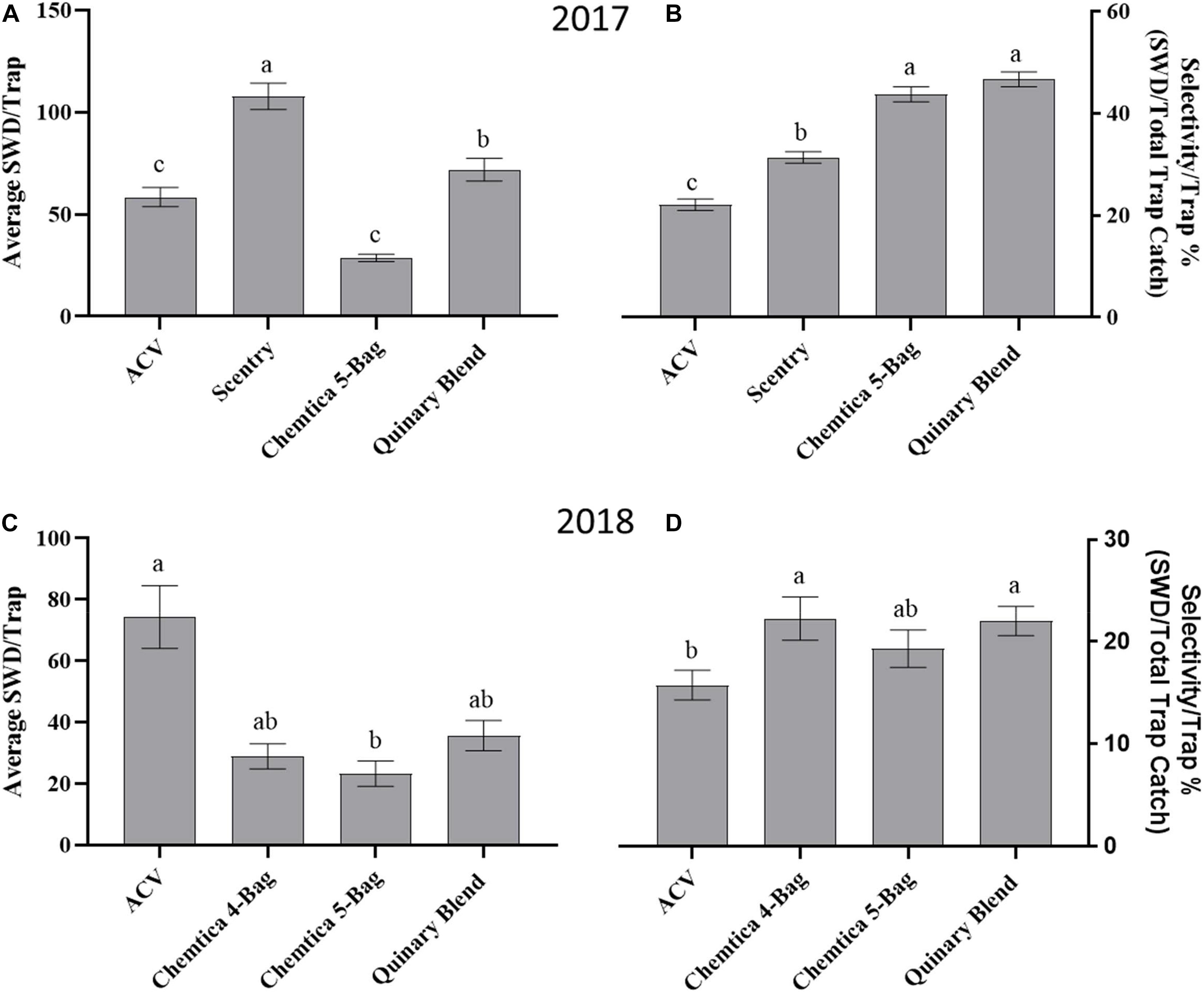
Figure 1. Average SWD catch per trap and selectivity/trap over the entire trapping period in Maryland in a blueberry field in 2017 and 2018 by traps baited with ACV (apple cider vinegar), Scentry dispenser, ChemTica dispenser, and a quinary dispenser. (A) average catch in the blueberry field in 2017 (N = 1330, df = 3, 379, F = 44.23, and P < 0.0001); (B) selectivity in the blueberry field in 2017 (N = 1309, df = 3, 1305, F = 49.81, and P < 0.0001); (C) average catch in the blueberry field in 2018 (N = 534, df = 3, 530, F = 3.092, and P = 0.0267); and (D) selectivity in the blueberry field in 2018 (N = 530, df = 3, 526, F = 4.651, and P = 0.0032). Means separated by One-way ANOVA with a Tukey’s post-test. Error bars represent standard error. Different letters above bars in each subfigure indicate significant differences at α = 0.05. Data represented are untransformed.
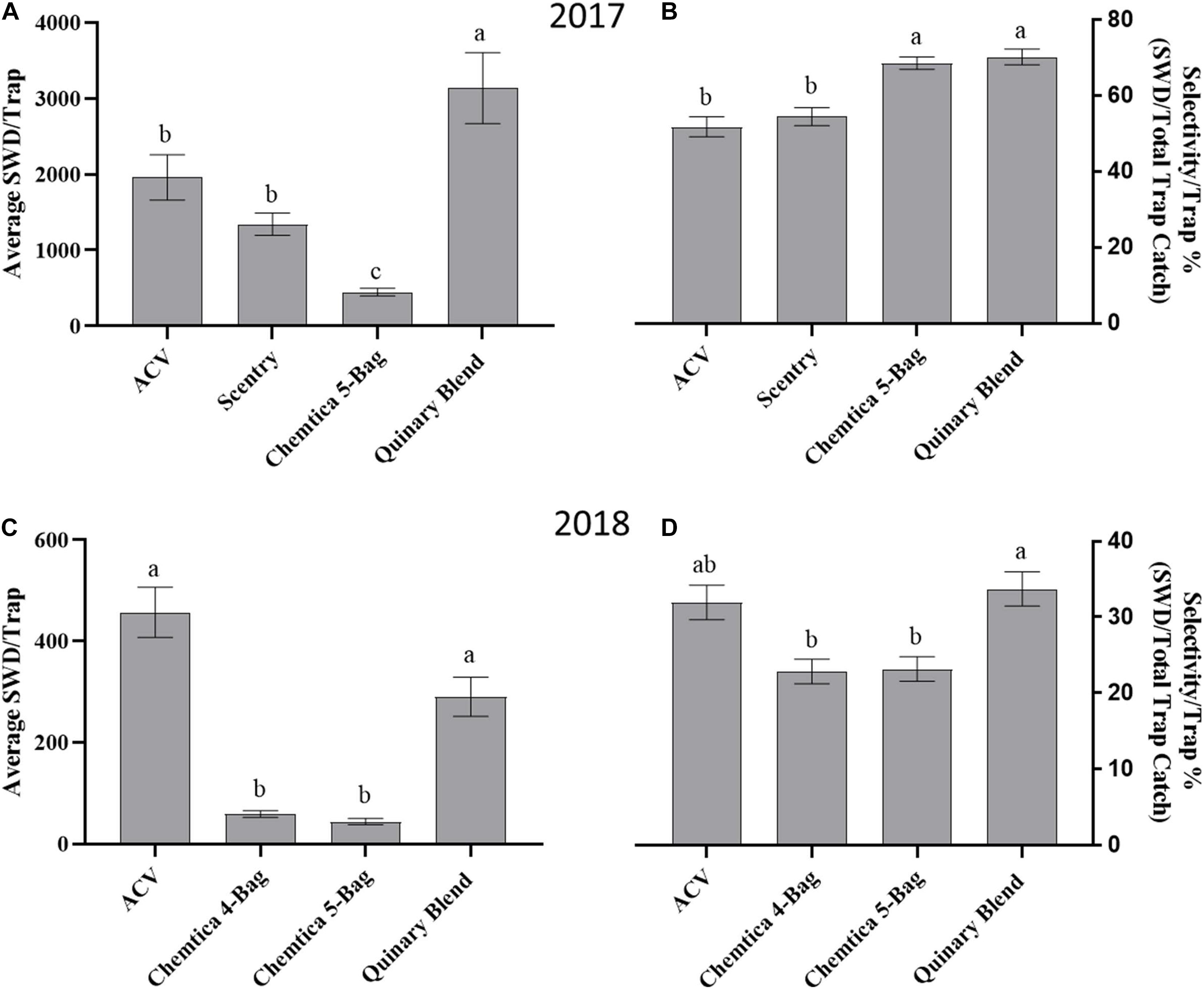
Figure 2. Average SWD catch per trap and selectivity per trap for the entire trapping period in Maryland in a wooded area near the blueberry field in 2017 and 2018 by traps baited with ACV (apple cider vinegar), Scentry dispenser, ChemTica dispenser 5-bag, ChemTica dispenser 4-bag, and a quinary dispenser. (A) average catch in the wooded area in 2017 (N = 539, df = 3, 535, F = 12.26, and P < 0.0001); (B) selectivity in the wooded area in 2017 (N = 538, df = 3, 534, F = 18.41, and P < 0.0001); (C) average catch in the wooded area in 2018 (N = 555, df = 3, 551, F = 24.54, and P < 0.0001); and (D) selectivity in the wooded area in 2018 (N = 547, df = 3, 543, F = 4.733, and P = 0.0029). Means separated by One-way ANOVA with a Tukey’s post-test. Error bars represent standard error. Different letters above bars in each subfigure indicate significant differences at α = 0.05. Data represented are untransformed.
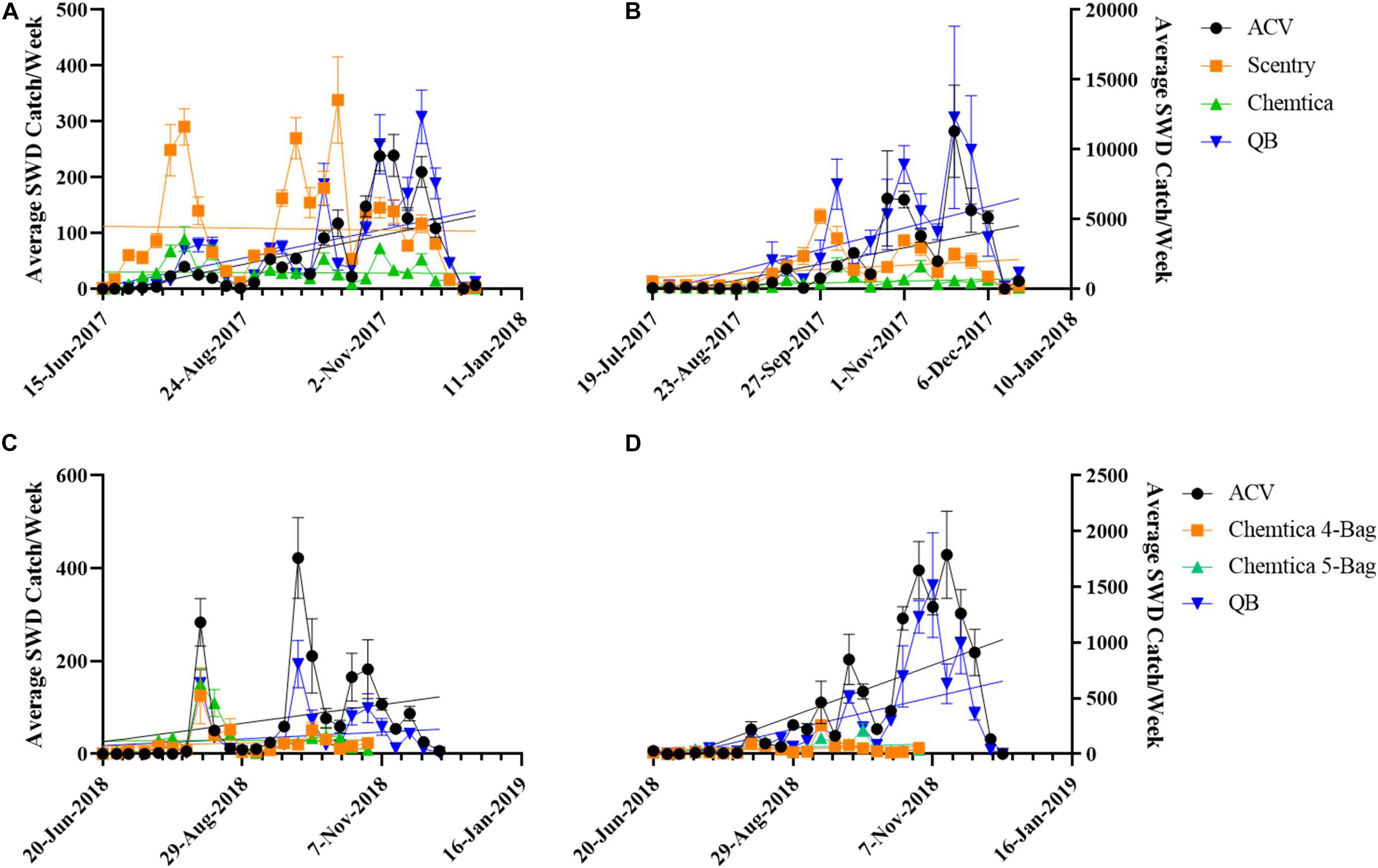
Figure 3. Average capture of SWD per week over the entire 2017 and 2018 trapping periods. (A) Blueberry field in Maryland 2017 [apple cider vinegar (ACV): Y = 5.228X–8.541, R2 = 0.2404, Deviation from 0 significant P < 0.0001; Scentry: Y = -0.3306X + 112.2, R2 = 0.0005, Deviation from 0 not significant P = 0.6821; ChemTica: Y = –0.0912X + 30.42, R2 = 0.0004, Deviation from 0 not significant P = 0.6988; and quinary blend (QB): Y = 5.112X + 3.995, R2 = 0.1606, Deviation from 0 significant P < 0.0001]; (B) Wooded area near a blueberry field in Maryland 2017 (ACV: Y = 231.9X–536.3, R2 = 0.2085, Deviation from 0 significant P < 0.0001; Scentry: Y = 59.73X + 804.2, R2 = 0.0636, Deviation from 0 significant P = 0.003; ChemTica: Y = 25.36X + 178.3, R2 = 0.0791, Deviation from 0 significant P = 0.001; and QB: Y = 308.1X–251.7, R2 = 0.1394, Deviation from 0 significant P < 0.0001); (C) Blueberry field in Maryland 2018 (ACV: Y = 4.011X + 26.16, R2 = 0.0538, Deviation from 0 significant P = 0.0043; ChemTica 4-bag: Y = 0.6949X + 16.67, R2 = 0.0079, Deviation from 0 not significant P = 0.3349; ChemTica 5-bag: Y = 0.1086X + 27.88, R2 = 0.0002, Deviation from 0 not significant P = 0.8809; and QB: Y = 1.498X + 18.02, R2 = 0.0315, Deviation from 0 significant P = 0.0299); and (D) Wooded area near a blueberry field in Maryland 2018 (ACV: Y = 45.61X–113.2, R2 = 0.3058, Deviation from 0 significant P < 0.0001; ChemTica 4-bag: Y = 2.528X + 19.93, R2 = 0.0467, Deviation from 0 significant P = 0.0178; ChemTica 5-bag: Y = 2.913X + 31.17, R2 = 0.0542, Deviation from 0 significant P = 0.0105; and QB: Y = 28.7X–63.2, R2 = 0.1917, Deviation from 0 significant P < 0.0001).
Average SWD capture and selectivity per trap, from a raspberry field and wooded area within Maryland in 2017, are found in Figure 4. In the field, ACV and QB dispenser baited traps captured the largest number of SWD individuals per trap, while ChemTica dispenser baited traps captured the fewest (Figure 4A). However, ChemTica and QB dispenser baited traps had the highest selectivity per trap out of all the trapping systems (Figure 4B). Within the wooded area, QB captured the largest number of SWD individuals compared to the other trapping systems (Figure 4C), and like what was seen in the field both QB and ChemTica dispenser baited traps had the highest selectivity (Figure 4D). Over the entire trapping period within the field there was a significant increase in SWD capture per week over time (Figure 5A). However, within the wooded area only traps baited with the QB, ACV, and ChemTica dispensers significantly increased over time (Figure 5B). Combining dispenser captures from the field and wooded area, ACV baited traps captured 210,711; QB dispenser baited traps captured 439,436; Scentry dispenser baited traps captured 169,000; and ChemTica dispenser captured 65,366 SWD individuals.
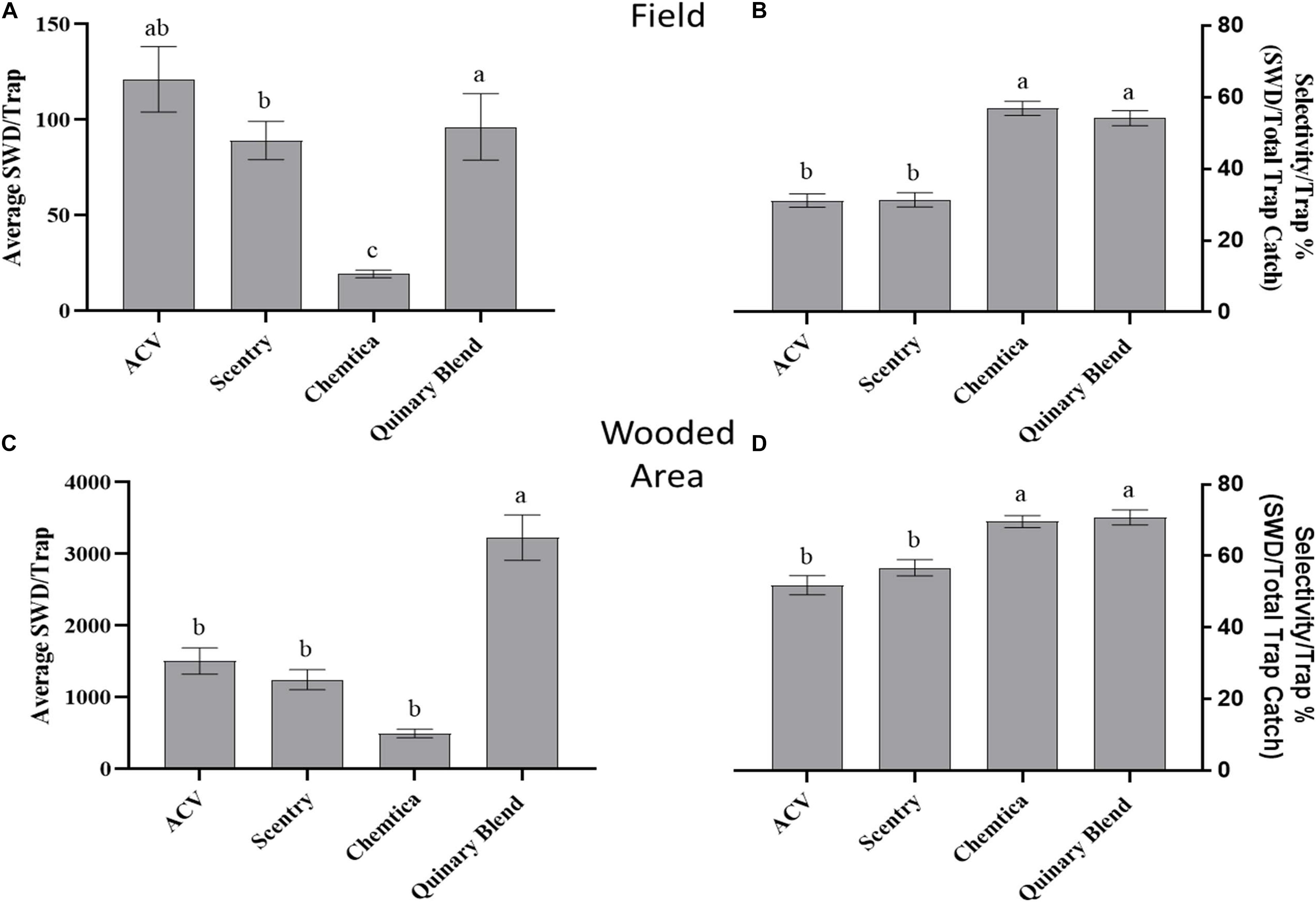
Figure 4. Average SWD capture per trap and overall selectivity over 8 weeks of trapping period in Maryland in a raspberry field and nearby wooded area in 2017 (July 19 to August 9) by traps baited with ACV (apple cider vinegar), Scentry dispenser, ChemTica dispenser, and a quinary dispenser. (A) average capture in the raspberry field in 2017 (N = 532, df = 3, 528, F = 14.66, and P < 0.001); (B) selectivity in the wooded area in 2017 (N = 531, df = 3, 527, F = 46.95, and P < 0.001); (C) average capture in the wooded area in 2017 (N = 511, df = 3, 507, F = 17.62, and P < 0.0001); and (D) selectivity in the wooded area in 2017 (N = 498, df = 3, 494, F = 18.48, and P < 0.0001). Means separated by one-way ANOVA with a Tukey’s post-test. Error bars represent standard error. Different letters above bars in each subfigure indicate significant differences at α = 0.05. Data represented are untransformed.
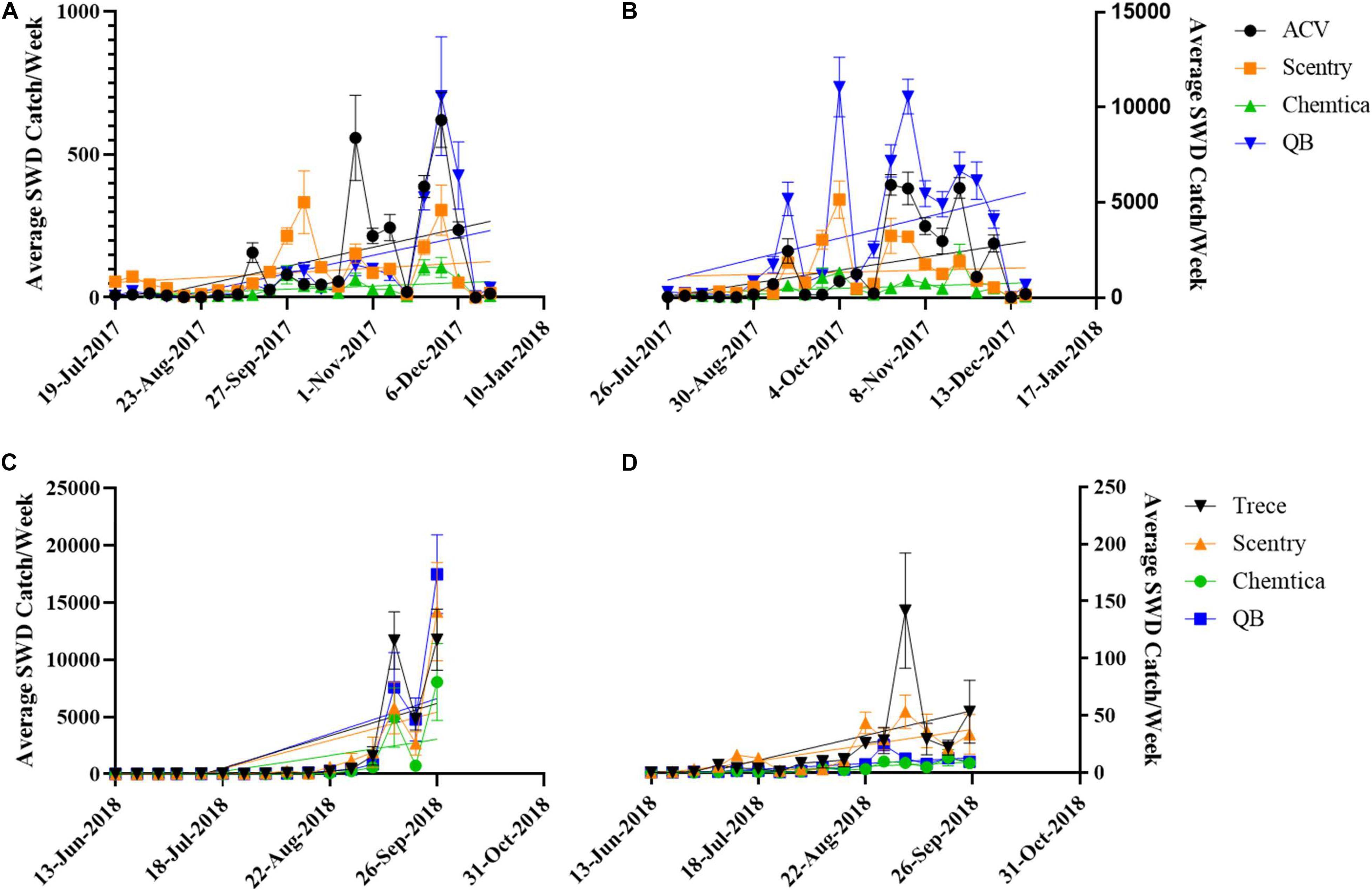
Figure 5. Average capture of SWD per week over the entire 2017 and 2018 trapping periods in Maryland, New Jersey, and West Virginia. (A) Raspberry field in Maryland in 2017 [apple cider vinegar (ACV): Y = 13.28X–23.82, R2 = 0.1923, Deviation from 0 significant P < 0.0001; Scentry: Y = 3.336X + 52.83, R2 = 0.03561, Deviation from 0 significant P = 0.0284; ChemTica: Y = 2.317X + 5.56, R2 = 0.09525, Deviation from 0 significant P = 0.0005; quinary blend (QB): Y = 12.7X–43.35, R2 = 0.1705, Deviation from 0 significant P < 0.0001]; (B) Wooded area near a raspberry field in Maryland in 2017 (ACV: Y = 137.5X + 68.18, R2 = 0.1773, Deviation from 0 significant P < 0.0001; Scentry: Y = 21.84X + 1107, R2 = 0.0064, Deviation from 0 not significant P = 0.3917; ChemTica: Y = 26.73X + 216.7, R2 = 0.055, Deviation from 0 significant P = 0.0096; QB: Y = 219.7X + 921, R2 = 0.1457, Deviation from 0 significant P < 0.0001); (C) Blueberry fields in New Jersey in 2018 (Trécé: Y = 565.1X–2301, R2 = 0.362, Deviation from 0 significant P < 0.0001; Scentry: Y = 496.9X–2026, R2 = 0.2724, Deviation from 0 significant P < 0.0001; ChemTica: Y = 282.2X–1190, R2 = 0.1819, Deviation from 0 significant P < 0.0001; QB: Y = 615.6X–2632, R2 = 0.3064, Deviation from 0 significant P < 0.0001); and (D) Raspberry field in West Virginia in 2018 (Trécé: Y = 4.345X–10.96, R2 = 0.2086, Deviation from 0 significant P = 0.0001; Scentry: Y = 2.757X–3.547, R2 = 0.3463, Deviation from 0 significant P < 0.0001; ChemTica: Y = 0.7385X–1.965, R2 = 0.3869, Deviation from 0 significant P < 0.0001; QB: Y = 1.015X–2.234, R2 = 0.3929, Deviation from 0 significant P < 0.0001).
Spotted-Wing Drosophila Captures in New Jersey (2018)
The average SWD capture and selectivity per trap from blueberry fields in New Jersey in 2018 are found in Figure 6. Traps baited with QB, Trécé, and Scentry dispensers captured the largest number of SWD per trap; however, QB and ChemTica dispenser baited trap numbers were not significantly different (Figure 6A). There was not a significant difference in selectivity between any of the trapping systems (Figure 6B). Over the course of the entire trapping period, there was a significant increase in SWD capture per week for each dispenser (Figure 5C). In total, QB dispenser baited traps captured 158,363; Trécé dispenser baited traps captured 154,596; Scentry dispenser baited traps captured 135,666; and ChemTica dispenser baited traps captured 73,917 SWD individuals.
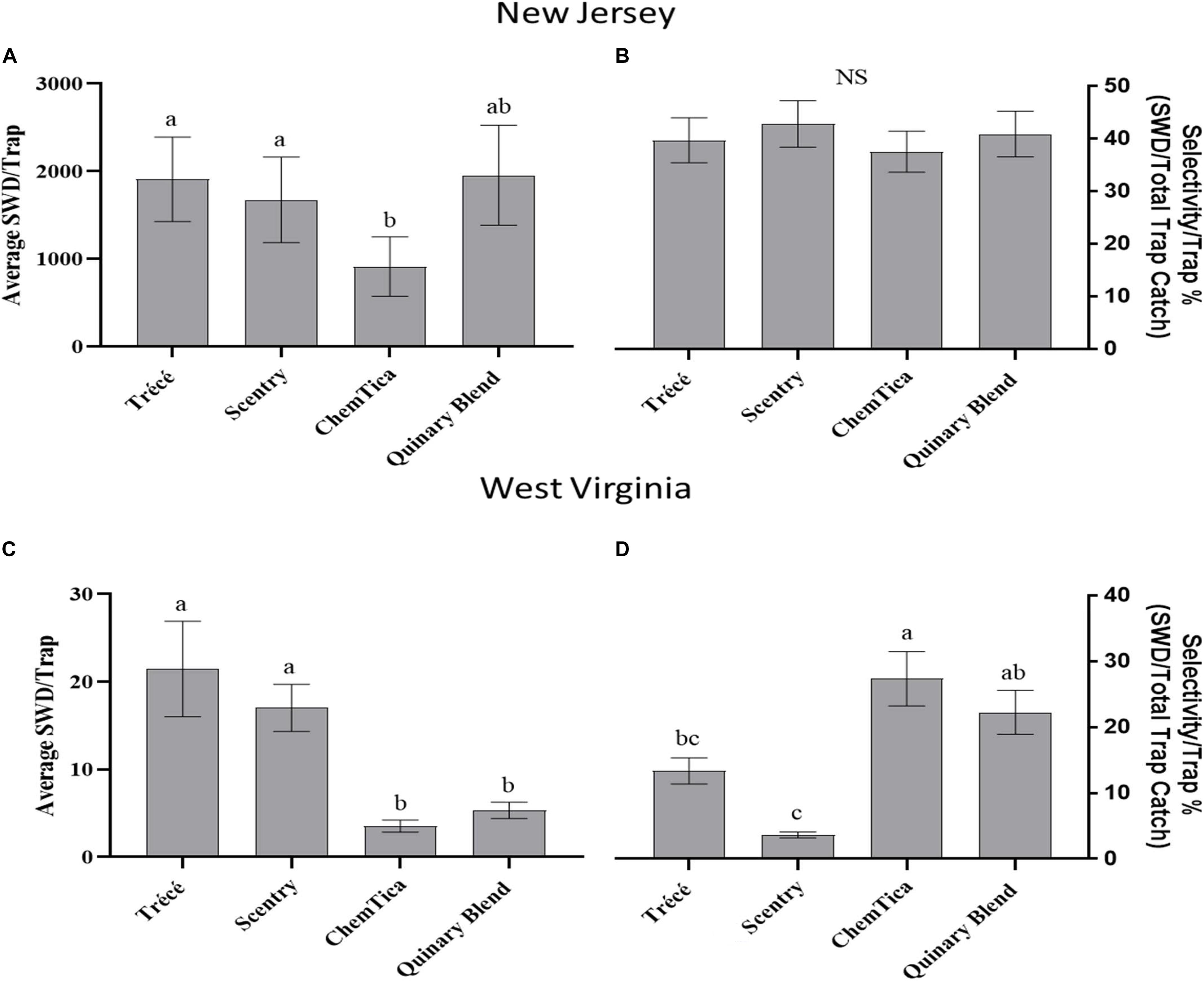
Figure 6. Average SWD catch per trap and selectivity per trap over the entire trapping period in New Jersey in blueberry bushes and West Virginia in a raspberry field in 2018. Traps baited with Trécé dispenser, Scentry dispenser, ChemTica dispenser, and a quinary dispenser. (A) average catch in the blueberry bushes in New Jersey in 2018 (N = 324, df = 3, 320, F = 4.573, and P = 0.0038); (B) selectivity in the blueberry bushes in 2018 (N = 317, df = 3, 313, F = 0.3954, and P = 0.7564); (C) average catch in the raspberry field in West Virginia in 2018 (N = 256, df = 3, 252, F = 10.97, and P < 0.0001); and (D) selectivity in the raspberry field in West Virginia in 2018 (N = 242, df = 3, 238, F = 10.87, and P < 0.0001). Means separated by One-way ANOVA with a Tukey’s post-test. Error bars represent standard error. Different letters above bars in each subfigure indicate significant differences at α = 0.05. Data represented are untransformed.
Spotted-Wing Drosophila Captures in West Virginia (2018)
The average SWD capture and selectivity per trap from the raspberry field within West Virginia in 2018 are found in Figure 6. Traps baited with Trécé and Scentry dispensers captured significantly more SWD per trap than the other trap/dispenser systems (Figure 6C). The average selectivity of ChemTica and QB dispenser baited traps was shown to be higher than the other trap/dispenser systems; however, it was ChemTica dispenser baited traps that had a selectivity ratio significantly higher than the Trécé dispenser baited traps (Figure 6D). Over the course of the entire trapping period there was a significant increase in SWD capture per week for each dispenser (Figure 5D). In total, Trécé dispenser baited traps captured 1,374; Scentry dispenser baited traps captured 1,090; QB dispenser baited traps captured 342; and ChemTica dispenser baited traps captured 227 SWD individuals.
Non-Target Captures in Maryland (2017)
Breakdown of Maryland 2017 non-target captures shows that Scentry dispensers trapped significantly more non-target drosophila and other arthropods than the other dispensers within the blueberry field (Table 1). ACV baited traps captured the largest number of large flies. The QB and ChemTica dispenser baited traps captured non-significantly different numbers of each of the non-target categories. Non-target drosophila averages in the wooded area increased up to 10 times of what was caught in the field. Scentry dispenser baited traps captured the greatest number of non-target drosophila, while ACV baited traps captured the greatest number of large flies and other arthropods per trap. ChemTica dispenser baited traps captured the fewest non-target individuals compared to the other dispensers.
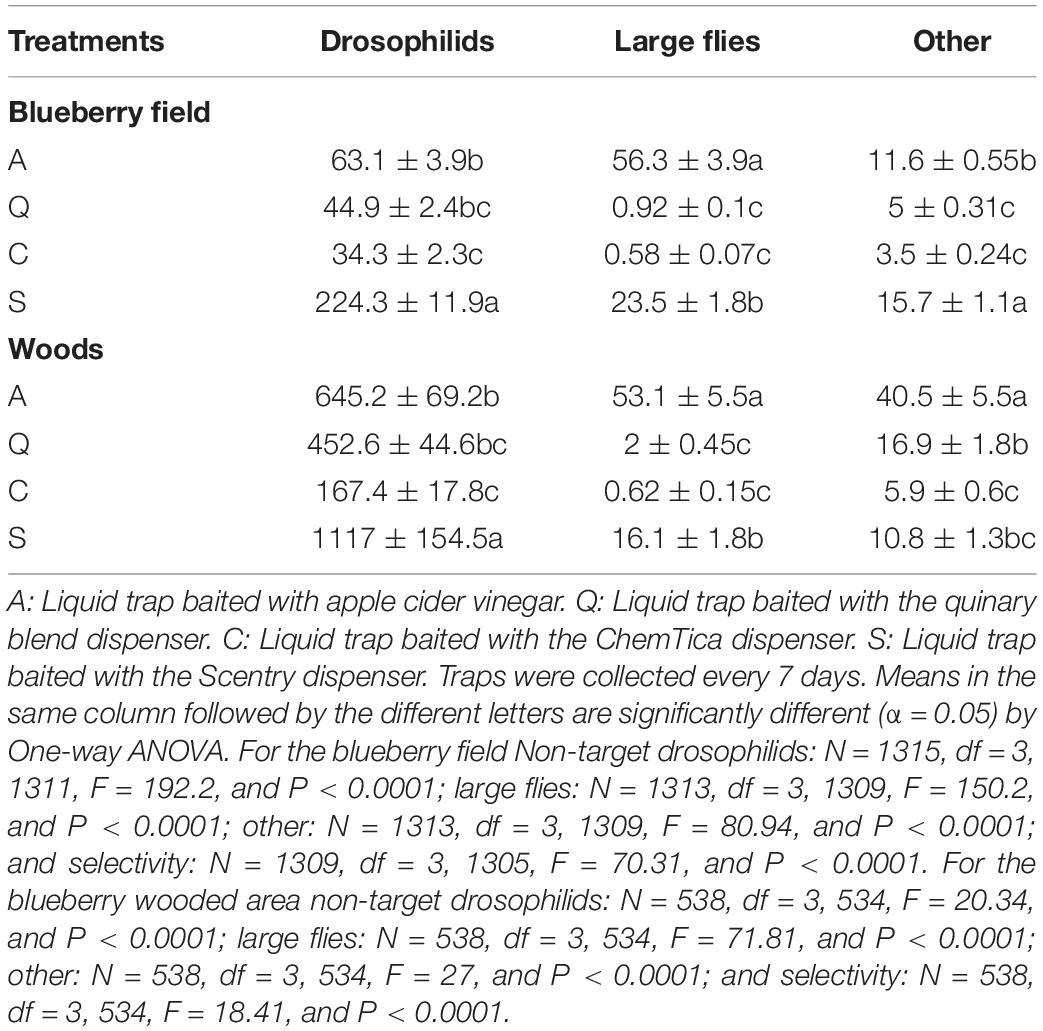
Table 1. Mean (±SE) catch (per trap) of non-target: drosophilids, large flies, and other arthropods over the course of trapping in a blueberry field (June 15 to December 19) and nearby wooded area (July 19 to December 19; Maryland) in 2017.
Breakdown of the non-target captures within the raspberry field in 2017 are found in Table 2 and show that traps baited with Scentry dispensers captured the largest number of non-target drosophila, while ACV baited traps captured the largest number of large flies per trap. Both dispensers captured similar numbers of other arthropods. The ChemTica and QB dispenser baited traps captured non-significantly different numbers of non-target drosophilids and large flies; however, the ChemTica dispenser baited traps captured the fewest number of other arthropods compared to the other dispensers. Non-target drosophila captures within the nearby wooded area increased up to 16-fold compared to raspberry field captures. Traps baited with the Scentry dispenser captured the largest number of non-target drosophila, while ACV baited traps captured the largest number of large flies and other arthropods. Traps baited with ChemTica captured the fewest non-target drosophila and other arthropods per trap compared to the other dispensers, and both this and the QB dispenser captured the fewest large flies per trap.
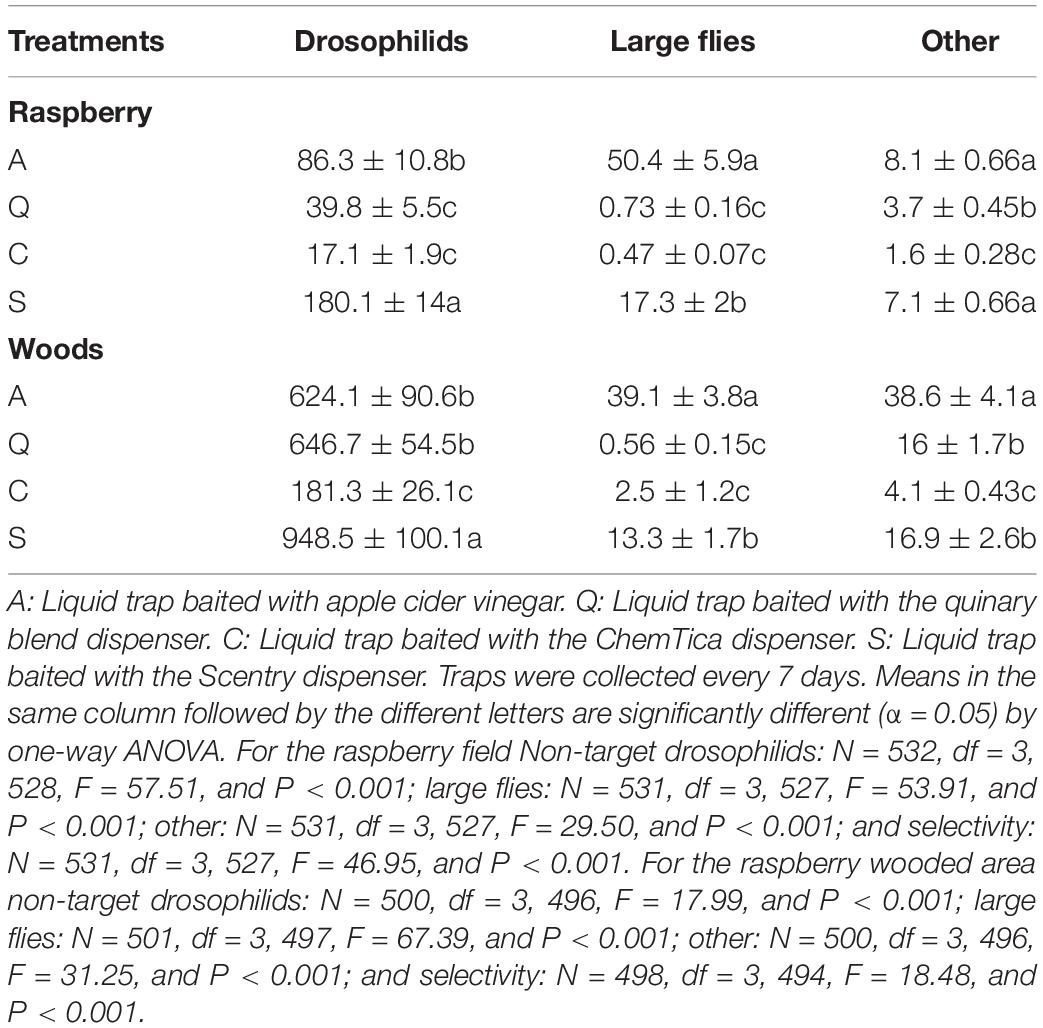
Table 2. Mean (±SE) capture (per trap) of non-target: drosophilids, large flies, and other arthropods over the course of trapping (July 19 to December 19) in a raspberry field and nearby wooded area (Maryland) in 2017.
Non-Target Captures in Maryland (2018)
Breakdown of non-target captures within Maryland in 2018 is found in Table 3. Within the blueberry field, ACV baited traps captured significantly more of each of the non-target types than any of the other dispensers. QB dispenser baited traps captured the fewest large flies per trap, while both ChemTica dispensers captured the fewest numbers of other arthropods. Within the wooded area, ACV baited traps captured the largest number of large flies and other arthropods per trap. Both QB and ACV baited traps caught significantly higher numbers of non-target drosophila compared to the ChemTica dispensers. Traps baited with the ChemTica 5-bag dispenser captured the fewest number of non-target drosophila and other arthropods.
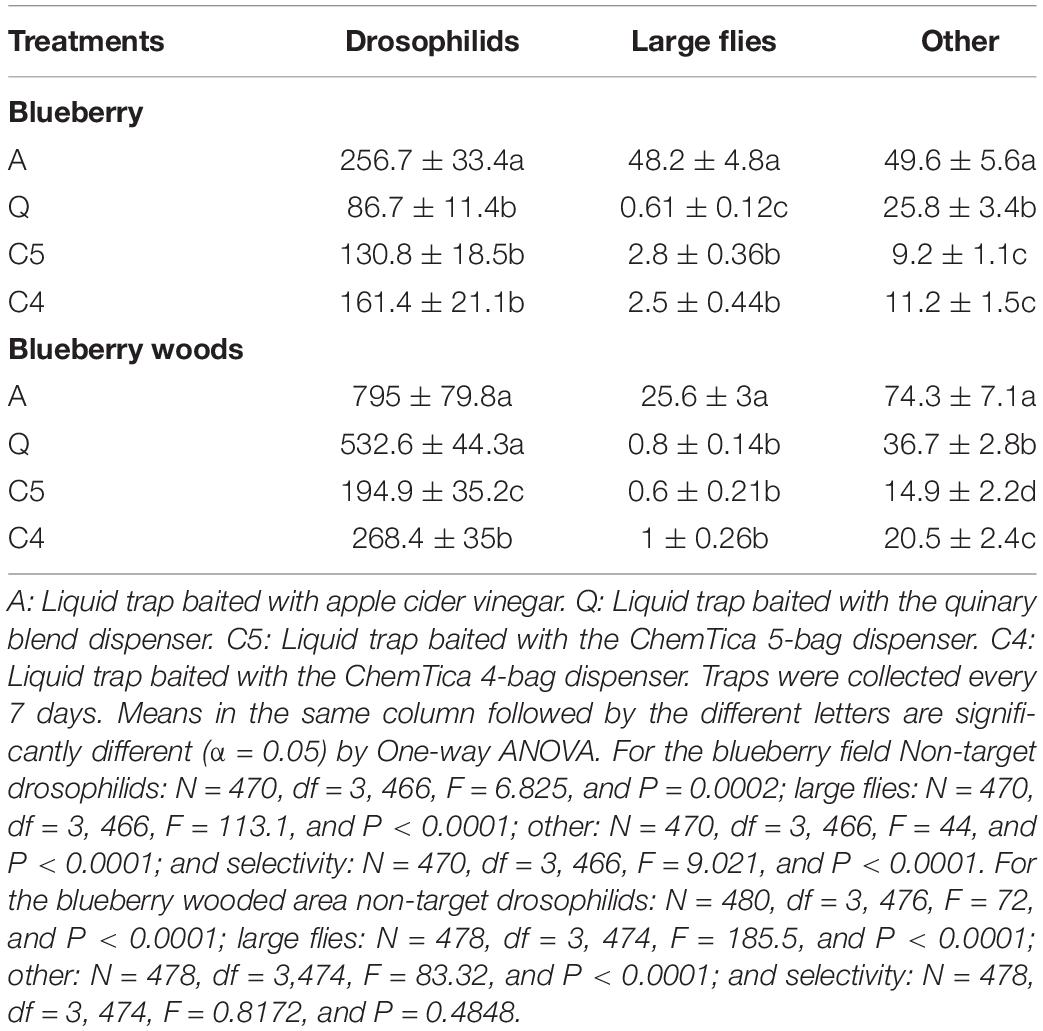
Table 3. Mean (±SE) catch (per trap) of non-target: drosophilids, large flies, and other arthropods over the course of trapping (June 13 to October 31; Maryland) in 2018.
Non-Target Captures in New Jersey and West Virginia (2018)
Breakdown of the non-target captures in New Jersey and West Virginia is found in Table 4. In New Jersey, traps baited with the ChemTica dispenser captured the fewest non-target drosophila. Trécé and Scentry dispenser baited traps captured the largest number of non-target drosophila individuals, while the QB dispenser baited traps caught significantly more than ChemTica dispenser baited traps, but not significantly less than Trécé dispenser baited traps. Large fly captures were found to be highest in the Trécé and Scentry dispenser baited traps and lowest in the ChemTica and QB dispenser baited traps. A similar trend was seen with other flies; however, the Scentry dispenser baited trap capture average was not significantly different from the ChemTica or QB dispenser baited trap capture average. In West Virginia, traps baited with the Scentry dispenser captured significantly more non-target drosophila per trap than the other three dispensers. Trécé dispenser baited traps captured the next largest numbers per trap, followed by the QB and finally the ChemTica dispenser baited traps. Non-target large flies, other flies, or other arthropods were not caught in the traps placed in the raspberry field in West Virginia.
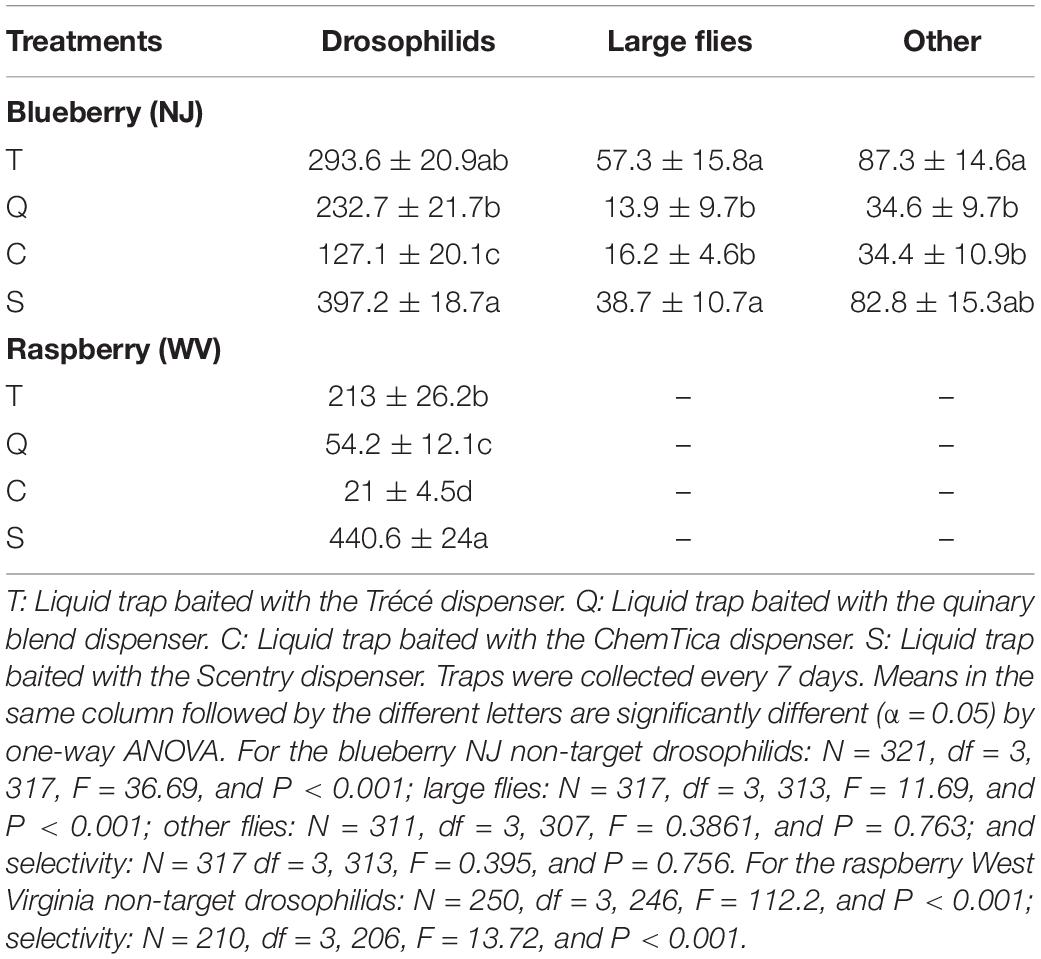
Table 4. Mean (±SE) capture (per trap) of non-target: drosophilids, large flies, and other arthropods over the course of trapping (June 13 to September 26) in blueberry New Jersey (NJ) and raspberry West Virginia (WV) in 2018.
Discussion
During the summer and fall of 2017 and 2018, field trials were conducted to compare a QB of acetic acid, ethyl acetate, phenethyl alcohol, acetoin, and ethyl octanoate to the commercially available SWD dispensers made by Scentry and Trécé. Our results indicate that a proprietarily formulated version of the QB, the ChemTica dispenser, consistently performed better in terms of selectivity per trap than the standard ACV bait and the commercial dispensers, produced by Scentry and Trécé (Figures 1–4B,D). Conversely, the commercial dispensers regularly performed better in terms of the number of SWD captured per trap (Figures 1, 3A, 4A,C). Additionally, prior to this study the ChemTica dispenser had only been tested as a 5-bag formulation. The purpose of testing the 4-bag formulation was to reflect more accurately the way the QB dispenser had originally been tested in the field, by combining the two attractants acetoin, and ethyl octanoate into one bag. As there was no significant difference between the two ChemTica formulations, we will further refer to them both as the ChemTica dispenser.
There have been several variations of SWD dispensers that have ranged from 4 to 11 components based on volatiles from raspberry, wine, and yeast (Cha et al., 2014; Abraham et al., 2015; Tonina et al., 2018). The Scentry and Trécé dispensers, developed from those prior versions, are proprietarily formulated four-component mixtures of acetic acid, ethanol, acetoin, and methionol (Cha et al., 2014). Prior research has demonstrated that the 4-component synthetic mixture was more attractive and had greater selectivity than the standard ACV bait (Cha et al., 2015). In commercial formulations, the selectivity of the Scentry and Trécé dispensers within blueberries was shown to be ca. 16.3 and 15.1%, and ca. 11.2 and 7.8%, respectively, within raspberries. This was a significant improvement over the selectivity of ACV that was found to be ca. 6.5% in blueberries and 5.3% within raspberries (Cha et al., 2018). In this study, the selectivity of the Scentry dispenser ranged from 1 to 30%, while the selectivity of the Trécé dispenser ranged from 6 to 13% depending upon the year and location. Poor selectivity (in terms of low value as well as high variability due to regional and temporal placement) and efficacy have repeatedly been cited as barriers to achieving a highly successful SWD dispenser (Basoalto et al., 2013; Iglesias et al., 2014; Feng et al., 2018; Tonina et al., 2018; Larson et al., 2020). Improving the efficacy and selectivity of a dispenser can have several positive effects including reduction in beneficial by-capture, increased ease of identification of the target pest, ability to mass-trap or trap-out the pest, and a reduction in decaying off-target bio-mass which in turn could improve the length of time a dispenser is attractive (Adams et al., 1989; Landolt et al., 2012). Burrack et al. (2015) found that a synthetic dispenser based on the Trécé four-component dispenser achieved a selectivity of ca. 40% within blueberries (Burrack et al., 2015). Then in 2018, Feng et al. (2018) reported on a novel QB that achieved ca. 47% selectivity within blueberries. The present study has shown that the ChemTica QB formulation has a selectivity that ranges between 15 and 57% during the harvest season, a significant improvement over the non-formulated QB and the commercially available dispensers. A portion of the improvement in selectivity could be attributed to the fact that the dispenser components within the ChemTica dispenser are contained within bags that are meant to control the components’ release rates. Further support for this can be found in Larson et al. (2020) where the QB was formulated into polyethylene sachets as a controlled-release dispenser which resulted in the selectivity for this version of the QB to range between 41 and 51%.
It was also seen that, over the entire period of trapping, SWD captures increased over time. Previous studies have found that attraction and selectivity increase as the season progresses (Cloonan et al., 2019; Larson et al., 2020). This increase can likely be explained by the fact that as the season progresses there is an increase in fly population due to emergence from the berry hosts. Coupled with the fact that there is a reduction in viable resources within the field for SWD to utilize, this could result in the dispensers becoming more attractive. Hennig and Mazzi (2018) additionally found that fewer SWD individuals were captured where cherry fruit was abundantly available. Cloonan et al. (2019) lend support to this conclusion by stating that it is likely that the selection behavior of SWD is altered due to whether background odors, i.e., the presence of fruits/leaves, are present or not.
This current study additionally saw that attraction increased over the course of the harvest season with more captures occurring during late season (end of harvest) and off season, lending support to the theory that background odors within the field play a role within the behavioral decision making of SWD. It can additionally be speculated that the distance an individual SWD is from a trap during the harvest season plays a role in an SWD decision making process. Dependent on how far from the trap a dispenser odor can be detected by the SWD, the background odors (i.e., ripening berries) are more ubiquitous throughout the field providing more concentrated stimuli resulting in less dispenser acceptance.
While the selectivity of the QB and ChemTica dispensers show pronounced improvement over the commercial dispensers and ACV bait, the efficacy of the dispensers in terms of attractiveness is still lacking compared to the commercial dispensers in the field settings. Improved efficacy would allow for mass trapping, though as SWD has a broad host range (Bellamy et al., 2013; Asplen et al., 2015) this would likely be time consuming and expensive. Lower efficacy may not be problematic for growers as current control practices follow a zero-tolerance rule wherein, at the first detection of SWD, control measures are undertaken to reduce the impact of the pest (Iglesias et al., 2014; Burrack et al., 2015).
A potentially important aspect of a dispenser would be how early in a season to reliably detect SWD. The earlier a detection can be made the sooner management steps can be made by growers. Previously, the commercial dispensers have been shown to provide earlier detection for SWD compared to ACV (Cha et al., 2018), and Larson et al. (2020) showed that the QB provided earlier detection as well. Here, mixed results were found in early detection based on year and location. Within Maryland in 2017, the QB, ChemTica, and Scentry dispensers captured SWD during the first trapping week; however, the Scentry dispenser captured a larger number of SWD. A similar observation was made during the second week of trapping within New Jersey where Scentry dispensers captured three-fold more than the combined SWD capture of the QB and ChemTica dispensers. Then, during the third trapping week in West Virginia, the Scentry dispenser captured two-fold more SWD individuals than the combined capture from the QB and ChemTica dispensers. This indicates that the Scentry dispenser is potentially more sensitive to SWD than the QB and ChemTica dispensers. However, this could additionally be explained by the possibility that the Scentry dispenser has a larger dispenser surface of effect. With a larger dispenser surface of effect more SWD individuals could be attracted to the dispenser. Further testing would be required to establish the distance at which efficacy of the dispensers is diminished. Timing the placement of traps is another hurdle that needs to be taken into consideration when monitoring for this pest. SWD could be captured routinely during winter months (Rossi-Stacconi et al., 2016). In addition, the population during these months can likely play a role in determining when a grower could expect to see the next growing season’s pest pressure. Different regions will experience varying temperature fluctuations yearly during the winter months. Further studies would be recommended for these areas within this study to develop baseline information on winter populations of SWD to better inform the growers of the region onto when they could expect high pest pressure. In this study, we have demonstrated that a formulated version of the QB dispenser, consisting of AA, EA, PE, AT, and EO (Feng et al., 2018) had a significant increase in selectivity compared to the commercially available Scentry and Trécé dispensers as well as the standard ACV bait. Though sensitivity was compromised within QB dispenser baited traps the fact remains that growers utilize dispenser/trap systems to monitor for SWD and once detected enact further control methods to reduce the pest pressure. A dispenser at this point does not need to capture large quantities of SWD to provide this information, but one that has higher selectivity protects non-target beneficial insects such as pollinators. Additional testing is required to further improve attractiveness and selectivity by pairing this synthetic dispenser with an appropriately designed trapping system. The current study utilized the Victor® yellow jacket & flying insect trap system, which is a trap that has a prominent yellow top covering the entry holes. Previous work has shown that SWD are attracted to red and black colors predominantly more than other colors (Basoalto et al., 2013; Rice et al., 2016; Kirkpatrick et al., 2018). Development of a complete trapping system utilizing a positive visual cue in tandem with a highly selective dispenser, with proven early detection capability, would provide growers with a much-needed insect pest management tool that would enable them to make accurate and timely pest management decisions for their crops.
Data Availability Statement
The raw data supporting the conclusions of this article will be made available by the authors, without undue reservation.
Author Contributions
AZ, NL, CR-S, and TL conceived the research idea. AZ, NL, JS, CR-S, KC, BS, and TL conducted field bioassay. NL carried out data analyses. All authors contributed to the writing and reviewing of the manuscript.
Funding
This work was supported by the USDA NIFA Crop Protection and Pest Management Program (grant # 2015-70006-24152).
Conflict of Interest
KC and BS were currently employed by the company Trécé Inc.
The remaining authors declare that the research was conducted in the absence of any commercial or financial relationships that could be construed as a potential conflict of interest.
Acknowledgments
We thank Mahalet Nega, Ugochukwu Okeke, Robert Holdcraft, Vera Kyryczenko-Roth, Nicolas Firbas, Jennifer Frake, Kyra Huttinger, and Fernando Sanchez-Pedraza for laboratory and field assistance.
References
Abraham, J., Zhang, A., Angeli, S., Abubeker, S., Michel, C., Feng, Y., et al. (2015). Behavioral and antennal responses of Drosophila suzukii (Diptera: Drosophilidae) to volatiles from fruit extracts. Environ. Entomol. 44, 356–367. doi: 10.1093/ee/nvv013
Adams, R. G., Murray, K. D., and Los, L. M. (1989). Effectiveness and selectivity of sex pheromone lures and traps for monitoring fall armyworm (Lepidoptera: Noctuidae) adults in Connecticut sweet corn. J. Econ. Entomol. 82, 285–290.
Akasaka, N., Higashikubo, H., Ishii, Y., Sakoda, H., and Fujiwara, S. (2017). Polyamines in brown rice vinegar function as potent attractants for the spotted wing drosophila. J. Biosci. Bioeng. 123, 78–83. doi: 10.1016/j.jbiosc.2016.06.014
Asplen, M. K., Anfora, G., Biondi, A., Daane, K. M., Gutierrez, A. P., ZappalÃ, L., et al. (2015). Invasion biology of spotted wing Drosophila (Drosophila suzukii): a global perspective and future priorities. J. Pest Sci. 88, 469–494. doi: 10.1007/s10340-015-0681-z
Bal, H. K., Adams, C., and Grieshop, M. (2017). Evaluation of off-season potential breeding sources for spotted wing drosophila (Drosophila suzukii Matsumura) in Michigan. J. Econ. Entomol. 110, 2466–2470. doi: 10.1093/jee/tox252
Basoalto, E., Hilton, R., and Knight, A. (2013). Factors affecting the efficacy of a vinegar trap for Drosophila suzukii (Diptera; Drosophilidae). J. Appl. Entomol. 137, 561–570. doi: 10.1111/jen.12053
Beers, E. H., Van Steenwyk, R. A., Shearer, P. W., Coates, W. W., and Grant, J. A. (2011). Developing Drosophila suzukii management programs for sweet cherry in the western United States. Pest Manag. Sci. 67, 1386–1395. doi: 10.1002/ps.2279
Bellamy, D. E., Sisterson, M. S., and Walse, S. S. (2013). Quantifying host potentials: indexing postharvest fresh fruits for spotted wing drosophila, Drosophila suzukii. PLoS One 8:e61227. doi: 10.1371/journal.pone.0061227
Burrack, H. J., Asplen, M., Bahder, L., Collins, J., Drummond, F. A., Guedot, C., et al. (2015). Multistate comparison of attractants for monitoring Drosophila suzukii (Diptera: Drosophilidae) in blueberries and cranberries. Environ. Entomol. 44, 704–712. doi: 10.1093/ee/nvv022
Cai, P., Song, Y., Yi, C., Zhang, Q., Xia, H., Lin, J., et al. (2019). Potential host fruits for Drosophila suzukii: olfactory and oviposition preferences and suitability for development. Entomol. Exp. Appl. 167, 880–890. doi: 10.1111/eea.12840
Cha, D. H., Adams, T., Werle, C. T., Sampson, B. J., Adamczyk, J. J., Rogg, H., et al. (2014). A four-component synthetic attractant for Drosophila suzukii (Diptera: Drosophilidae) isolated from fermented bait headspace. Pest Manag. Sci. 70, 324–331. doi: 10.1002/ps.3568
Cha, D. H., Hesler, S. P., Park, S., Adams, T. B., Zack, R. S., Rogg, H., et al. (2015). Simpler is better: fewer non-target insects trapped with a four-component chemical lure vs. a chemically more complex food-type bait for Drosophila suzukii. Entomol. Exp. Appl. 154, 251–260. doi: 10.1111/eea.12276
Cha, D. H., Hesler, S. P., Wallingford, A. K., Zaman, F., Jentsch, P., Nyrop, J., et al. (2018). Comparison of commercial lures and food baits for early detection of fruit infestation risk by Drosophila suzukii (Diptera: Drosophilidae). J. Econ. Entomol. 111, 645–652. doi: 10.1093/jee/tox369
Cloonan, K. R., Hernandez-Cumplido, J., De Sousa, A. L. V., Ramalho, D. G., Burrack, H. J., Della Rosa, L., et al. (2019). Laboratory and field evaluation of host-related foraging odor-cue combinations to attract Drosophila suzukii (Diptera: Drosophilidae). J. Econ. Entomol. 112, 2850–2860. doi: 10.1093/jee/toz224
Dreves, A. J., Walton, V. M., and Fisher, G. (2009). A New Pest Attacking Healthy Ripening Fruit in Oregon. Spotted wing Drosophila: Drosophila suzukii (Matsumura). Available online at: https://catalog.extension.oregonstate.edu/em8991 (accessed on 27 February 2021).
Farnsworth, D., Hamby, K. A., Bolda, M., Goodhue, R. E., Williams, J. C., and Zalom, F. G. (2017). Economic analysis of revenue losses and control costs associated with the spotted wing drosophila, Drosophila suzukii (Matsumura), in the California raspberry industry. Pest Manag. Sci. 73, 1083–1090. doi: 10.1002/ps.4497
Feng, Y., Bruton, R., Park, A., and Zhang, A. (2018). Identification of attractive blend for spotted wing drosophila, Drosophila suzukii, from apple juice. J. Pest Sci. 91, 1251–1267. doi: 10.1007/s10340-018-1006-9
Feng, Y., and Zhang, A. (2017). A floral fragrance, methyl benzoate, is an efficient green pesticide. Sci. Rep. 7:42168. doi: 10.1038/srep42168
Goodhue, R. E., Farnsworth, D., Williams, J. C., Bolda, M., and Zalom, F. G. (2011). Spotted wing drosophila infestation of California strawberries and raspberries: economic analysis of potential revenue losses and control costs. Pest Manag. Sci. 67, 1396–1402. doi: 10.1002/ps.2259
Hamby, K. A., and Becher, P. G. (2016). Current knowledge of interactions between Drosophila suzukii and microbes, and their potential utility for pest management. J. Pest Sci. 89, 621–630. doi: 10.1007/s10340-016-0768-1
Hauser, M. (2011). A historic account of the invasion of Drosophila suzukii (Matsumura) (Diptera: Drosophilidae) in the continental United States, with remarks on their identification. Pest Manag. Sci. 67, 1352–1357. doi: 10.1002/ps.2265
Hennig, E. I., and Mazzi, D. (2018). Spotted wing drosophila in sweet cherry orchards in relation to forest characteristics, bycatch, and resource availability. Insects 9:118. doi: 10.3390/insects9030118
Iglesias, L. E., Nyoike, T. W., and Liburd, O. E. (2014). Effect of trap design, bait type, and age on captures of Drosophila suzukii (Diptera: Drosophilidae) in berry crops. J. Econ. Entomol. 107, 1508–1518. doi: 10.1603/ec13538
Jaffe, B. D., Avanesyan, A., Bal, H. K., Feng, Y., Grant, J., Grieshop, M. J., et al. (2018). Multistate comparison of attractants and the impact of fruit development stage on trapping Drosophila suzukii (Diptera: Drosophilidae) in raspberry and blueberry. Environ. Entomol. 47, 935–945.
Kirkpatrick, D. M., Gut, L. J., and Miller, J. R. (2018). Development of a novel dry, sticky trap design incorporating visual cues for Drosophila suzukii (Diptera: Drosophilidae). J. Econ. Entomol. 111, 1775–1779. doi: 10.1093/jee/toy097
Kirkpatrick, D. M., McGhee, P. S., Gut, L. J., and Miller, J. R. (2017). Improving monitoring tools for spotted wing drosophila, Drosophila suzukii. Entomol. Exp. Appl. 164, 87–93. doi: 10.1111/eea.12602
Kleiber, J. R., Unelius, C. R., Suckling, D. M., Lee, J. C., Qian, M. C., and Bruck, D. J. (2014). Attractiveness of fermentation and related products to spotted wing drosophila (Diptera: Drosophilidae). Environ. Entomol. 43, 439–447. doi: 10.1603/EN13224
Landolt, P. J., Adams, T., and Rogg, H. (2012). Trapping spotted wing drosophila, Drosophila suzukii (Matsumura) (Diptera: Drosophilidae), with combinations of vinegar and wine, and acetic acid and ethanol. J. Appl. Entomol. 136, 148–154. doi: 10.1111/j.1439-0418.2011.01646.x
Larson, N. R., Strickland, J., Shields, V. D. C., and Zhang, A. (2020). Controlled-release dispenser and dry trap developments for Drosophila suzukii detection. Front. Ecol. Evol. 8:45. doi: 10.3389/fevo.2020.00045
Lee, J. C., Bruck, D. J., Dreves, A. J., Ioriatti, C., Vogt, H., and Baufeld, P. (2011). In focus: spotted wing drosophila, Drosophila suzukii, across perspectives. Pest Manag. Sci. 67, 1349–1351. doi: 10.1002/ps.2271
Mallis, A. (1969). Handbook of Pest Control: The Behavior, Life History, and Control of Household Pests. New York, NY: Mac NairDorland Co.
Mazzetto, F., Pansa, M. G., Ingegno, B. L., Tavella, L., and Alma, A. (2015). Monitoring of the exotic fly Drosophila suzukii in stone, pome and soft fruit orchards in NW Italy. J. Asia Pac. Entomol. 18, 321–329. doi: 10.1016/j.aspen.2015.04.001
Mortelmans, J., and Beliën, H. C. (2012). Drosophila suzukii (Diptera: Drosophilidae): a pest species new to Belgium. Belg. J. Zool. 142, 143–146.
Rice, K. B., Short, B. D., Jones, S. K., and Leskey, T. C. (2016). Behavioral responses of Drosophila suzukii (Diptera: Drosophilidae) to visual stimuli under laboratory, semi-field, and field conditions. Environ. Entomol. 45, 1480–1488. doi: 10.1093/ee/nvw123
Rossi-Stacconi, M. V., Kaur, R., Mazzoni, V., Ometto, L., Grassi, A., Gottardello, A., et al. (2016). Multiple lines of evidence for reproductive winter diapause in the invasive pest Drosophila suzukii: useful clues for control strategies. J. Pest Sci. 89, 689–700. doi: 10.1007/s10340-016-0753-8
Singh, S., Huang, J., and Grieshop, M. S. (2021). The presence and accessibility of competitive resources affect trapping efficiency of spotted-wing drosophila (Diptera: Drosophilidae). J. Econ. Entomol. 114, 486–491. doi: 10.1093/jee/toaa271
Tonina, L., Grassi, A., Caruso, S., Mori, N., Gottardello, A., Anfora, G., et al. (2018). Comparison of attractants for monitoring Drosophila suzukii in sweet cherry orchards in Italy. J. Appl. Entomol. 142, 18–25. doi: 10.1111/jen.12416
Walsh, D. B., Bolda, M. P., Goodhue, R. E., Dreves, A. J., Lee, J., Bruck, D. J., et al. (2011). Drosophila suzukii (Diptera: Drosophilidae): invasive pest of ripening soft fruit expanding its geographic range and damage potential. J. Integr. Pest Manag. 2, G1–G7. doi: 10.1603/IPM10010
Yeh, D. A., Drummond, F. A., Gomez, M. I., and Fan, X. (2020). The economic impacts and management of spotted wing drosophila (Drosophila Suzukii): the case of wild blueberries in Maine. J. Econ. Entomol. 113, 1262–1269. doi: 10.1093/jee/toz360
Keywords: spotted-wing drosophila, attractant, selectivity, early detection, population monitoring, insect pest management
Citation: Larson NR, Strickland J, Shields VD, Rodriguez-Saona C, Cloonan K, Short BD, Leskey TC and Zhang A (2021) Field Evaluation of Different Attractants for Detecting and Monitoring Drosophila suzukii. Front. Ecol. Evol. 9:620445. doi: 10.3389/fevo.2021.620445
Received: 22 October 2020; Accepted: 03 March 2021;
Published: 31 March 2021.
Edited by:
William Benjamin Walker III, Agricultural Research Service, United States Department of Agriculture (USDA-ARS), United StatesReviewed by:
Gianfranco Anfora, Fondazione Edmund Mach, ItalyDong H. Cha, Agricultural Research Service, United States Department of Agriculture, United States
Copyright © 2021 Larson, Strickland, Shields, Rodriguez-Saona, Cloonan, Short, Leskey and Zhang. This is an open-access article distributed under the terms of the Creative Commons Attribution License (CC BY). The use, distribution or reproduction in other forums is permitted, provided the original author(s) and the copyright owner(s) are credited and that the original publication in this journal is cited, in accordance with accepted academic practice. No use, distribution or reproduction is permitted which does not comply with these terms.
*Correspondence: Aijun Zhang, YWlqdW4uemhhbmdAdXNkYS5nb3Y=; YWlqdW4uemhhbmdAYXJzLnVzZGEuZ292
†ORCID: Cesar Rodriguez-Saona, orcid.org/0000-0001-5888-1769
 Nicholas R. Larson
Nicholas R. Larson Jaime Strickland
Jaime Strickland Vonnie D. Shields
Vonnie D. Shields Cesar Rodriguez-Saona
Cesar Rodriguez-Saona Kevin Cloonan3,4
Kevin Cloonan3,4 Tracy C. Leskey
Tracy C. Leskey Aijun Zhang
Aijun Zhang